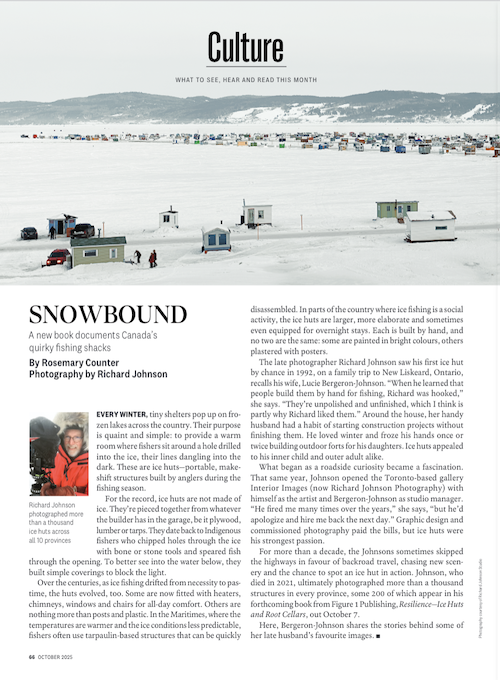Snowbound
Canada’s quirky fishing shacks
Every winter, tiny shelters pop up on frozen lakes across the country. Their purpose is quaint and simple: to provide a warm room where fishers sit around a hole drilled into the ice, their lines dangling into the dark. These are ice huts—portable, makeshift structures built by anglers during the fishing season.
For the record, ice huts are not made of ice. They’re pieced together from whatever the builder has in the garage, be it plywood, lumber or tarps. They date back to Indigenous fishers who chipped holes through the ice with bone or stone tools and speared fish through the opening. To better see into the water below, they built simple coverings to block the light.
Over the centuries, as ice fishing drifted from necessity to pastime, the huts evolved, too. Some are now fitted with heaters, chimneys, windows and chairs for all-day comfort. Others are nothing more than posts and plastic. In the Maritimes, where the temperatures are warmer and the ice conditions less predictable, fishers often use tarpaulin-based structures that can be quickly disassembled. In parts of the country where ice fishing is a social activity, the ice huts are larger, more elaborate and sometimes even equipped for overnight stays. Each is built by hand, and no two are the same: some are painted in bright colours, others plastered with posters.
The late photographer Richard Johnson saw his first ice hut by chance in 1992, on a family trip to New Liskeard, Ontario, recalls his wife, Lucie Bergeron-Johnson. “When he learned that people build them by hand for fishing, Richard was hooked,” she says. “They’re unpolished and unfinished, which I think is partly why Richard liked them.” Around the house, her handy husband had a habit of starting construction projects without finishing them. He loved winter and froze his hands once or twice building outdoor forts for his daughters. Ice huts appealed to his inner child and outer adult alike.
What began as a roadside curiosity became a fascination. That same year, Johnson opened the Toronto-based gallery Interior Images (now Richard Johnson Photography) with himself as the artist and Bergeron-Johnson as studio manager. “He fired me many times over the years,” she says, “but he’d apologize and hire me back the next day.” Graphic design and commissioned photography paid the bills, but ice huts were his strongest passion.
For more than a decade, the Johnsons sometimes skipped the highways in favour of backroad travel, chasing new scenery and the chance to spot an ice hut in action. Johnson, who died in 2021, ultimately photographed more than a thousand structures in every province.
